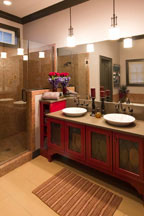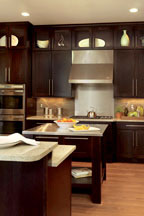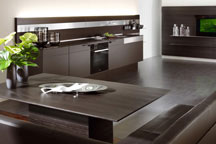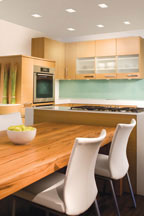 HACKETTSTOWN, NJ — Although the use of cherry wood in cabinetry is declining slightly, the preference for darker finishes continues to grow. These and other findings are among the top design trends for 2012, as determined by a recent survey by the National Kitchen & Bath Assn.
HACKETTSTOWN, NJ — Although the use of cherry wood in cabinetry is declining slightly, the preference for darker finishes continues to grow. These and other findings are among the top design trends for 2012, as determined by a recent survey by the National Kitchen & Bath Assn.
More than 350 NKBA member designers participated in the 2012 NKBA Design Trends Survey, which looked at the materials, product types, and styles incorporated into kitchen and bath designs over the final three months of 2011. Based on the NKBA's findings, here are the top 10 overall trends for kitchens and baths across the United States and Canada.
The NKBA noted that for the first time since tracking design trends in the kitchen and bathroom, transitional is slightly more popular than traditional type of design. Transitional, which blends traditional and contemporary, is "typified by lines that are simpler than traditional, but a bit more elaborate than contemporary in order to create a modern classic look." The group says the third most popular style is contemporary, followed by Shaker, Arts & Crafts, and Cottage.
 Kitchen Cabinetry Color Preferences
Kitchen Cabinetry Color Preferences
According to the NKBA survey, although cherry has consistently been among the top two most popular species for cabinetry, jockeying for the top spot with maple each year, designers are slowly shifting away from its usage. Heading into 2012, 69 percent of NKBA member kitchen designers said they are specifying cherry wood, a 3 percent decline from the 72 percent who specified it in 2011, and 11 percent from 2010 figures.
Maple, too, is declining in preference the NKBA reports, dropping from 77 percent in 2011 to 70 percent in early 2012. The survey said: "Instead, a number of lesser-used woods are being specified more often, including oak, which is specified by twice as many designers now (22%) versus two years ago (11%); walnut, which has increased from 3% in 2010 to 9% in 2011 to 13% today; birch, which is now specified by three times as many kitchen designers as it was a year ago (15% vs. 5%), and bamboo, which has doubled from 5% last year to 10% now. While alder is currently specified by 27% of kitchen designers, that figure is down from 30% last year and from 40% two years ago."
 Increase Usage of Darker Finishes
Increase Usage of Darker Finishes
As seen at the last year's KBIS, the use of darker natural finishes for wood cabinetry continues to be a growing trend, with a number of designers mixing dark and light for a tonal effect. According to the NKBA survey, "While light natural finishes have been recently specified by 30 percent of kitchen designers, medium natural finishes stand at 55 percent, with dark natural finishes at 58 percent." NKBA noted that dark natural finishes are being specified 15 percent more often than they were two years ago.
For painted cabinetry, white continues to be the color of choice, specified by 59 percent of NKBA member kitchen designers. Also noteworthy is the comeback of distressed finishes, rising to 22 percent compared to 5 percent last year.
 LED Lighting
LED Lighting
The preference for LED lighting is growing, with 70 percent of designers specifying their usage in kitchens. However, NKBA found, the use of compact fluorescent lights (CFLs) fell from 36 percent last year to 26 percent today, primarily because of the poor color of the light produced.
The Jan. 1, 2012, U.S. ban on 100-watt incandescent bulbs, and the 2013 ban on 75-watt incandescent bulbs and that of 60- and 40-watt incandescent bulbs a year later, will all impact their usage in kitchens of today and tomorrow.
Additional design trends on solid surfaces, backsplashes, faucets, etc. can be found here. More information is also available from the NKBA at NKBA.org, (800) THE-NKBA (843-6522).






Have something to say? Share your thoughts with us in the comments below.